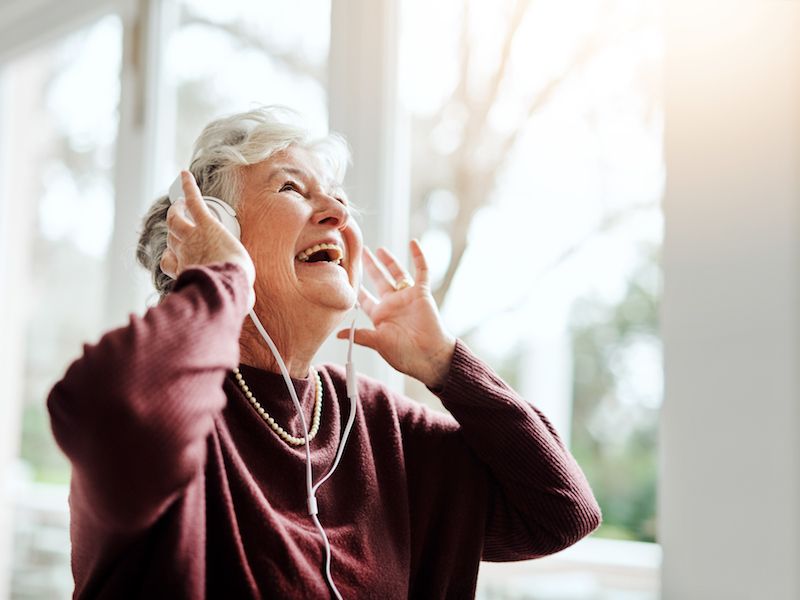
Noise-related loss of hearing doesn’t only impact people who work in loud environments, like construction workers or heavy metal roadies. It doesn’t even need to be work-related, leisure-related noise exposure can be dangerous, too. What kind of exposure are we dealing with? Music, gaming, streaming video or anything that you would listen to through earbuds or headphones.
You might be surprised to learn that a mobile device can get that loud. The typical pain threshold for human hearing is about 150 db which is well within the range of these devices. Your ears will literally start to feel pain at this volume. So what’s the plan to safeguard against this type of noise-related hearing loss?
The volume level here is important. Listen with the volume at or below 60% for no more than 60 minutes at a stretch (how long you listen for also matters), this is known as the 60/60 rule.
Create a Setting on Your Hearing Aids For Listening to Music
If you use hearing aids, you’re likely streaming your device directly to your hearing aids, so be certain the volume is not too loud or that you’re not trying to drown out other sounds with your music. Additionally, ask us about how to best listen to music. Hearing aids aren’t created to make music clearer like they do with voices so if really like music, you might have noticed this. We may be able to change the configuration to lessen feedback and noise while increasing some frequency to improve the quality of sound while listening to music.
What Are The Right Headphones For You?
When shopping for headphones there are many options, especially if you use hearing aids. It may be a matter of personal preference, but there are some things you should think about there too.
Headphones That go Over The Ears
Over the ear headphones are becoming popular again but you most likely won’t see the old foam covered ear pieces that once came with a walkman. Often surprisingly expensive, they offer a large variety of color options and celebrity endorsements, and yes, exceptional sound quality. And unlike those little foam pads, these go over the whole ear, stopping outside sounds.
Conventional wisdom is that these are less dangerous than in-ear headphones because the source of the sound is further away from your eardrum. But the reality is they’re usually capable of much louder sound than their smaller kin, the speakers are much larger. Noise cancellation can be a good thing as long as you’re not missing needed sounds such as an oncoming car. With that being said, because they block out outside noise, you can often reduce the volume of what you’re listening to so it’s not so loud that it will hurt your hearing.
Earbuds
The standard earbuds that are included with devices like iPhones are much maligned for their poor sound quality, but because they come along with your phone lots of people still use them. Specifically, with newer Apple phones, it’s simply easier to use the earbuds that were provided with the device because it most likely doesn’t have a headphone jack.
The drawback, besides the inferior sound quality, is that basic earbuds don’t block outside noises, so you’re more likely to crank up the sound level. Once again,, though it’s often said that earbuds are a problem because you stick them in your ear so their speakers are extremely close to your eardrum, volume is really the biggest problem.
Occluding or Isolating Earbuds
Many people choose earbuds with a rounded, rubbery tip both because they’re more comfortable than standard earbuds and better at blocking outside sounds. The rubber molds to the shape of your ear, producing a seal that stops other sounds from entering. But these earbuds can also block out noises you might need to hear and loud volume is still the main issue. Needless to say, these won’t work for you if you have hearing aids.
A number of pairs might have to be evaluated before you find headphones that work for you. Depending on what you’re most often using them for say talking on the phone, versus listening to music, you’ll have unique acoustic requirements. The essential thing is to seek out headphones that make it comfortable for you to listen at a safe and secure sound level.
Don’t Cut Corners When it Comes to Your Hearing
Is it Safe, How Can I be Sure? If you own a smartphone, you can get an app for that, you can get the National Institute for Occupational Safety and Health’s free Sound Level Meter app. You can get different apps, but studies has found that the accuracy of these other apps is spotty (in addition, for unknown reasons, Android-based apps have proven less reliable). That prompted NIOSH to create an app of their own. The app enables you to measure outside noises, but sounds coming from your device’s speakers can also be measured, in other words, the true volume of what’s being sent to your ears. It’s a little bit of work, but putting in place these types of preventative steps can help protect your ears.
